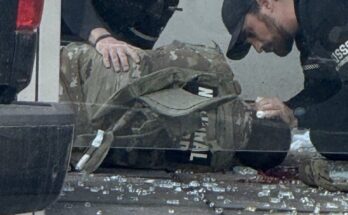
Tragedy at Terracina: Eurofighter Crashes During Airshow, Pilot Killed
On a sunny Sunday afternoon, September 24, 2017, what began as a celebratory aviation display in the Italian coastal town of Terracina ended in heartbreaking tragedy. A Eurofighter Typhoon, the pride of the Italian Air Force, crashed into the sea during an airshow, killing the pilot instantly. Thousands of spectators, many with their families, were watching the event unfold from the shoreline when the horrifying accident occurred.
The incident happened just moments before the finale of the airshow, which was being held as part of an annual aviation celebration. The Eurofighter, a highly advanced multirole combat aircraft developed by a European consortium including Italy, was performing a series of aerial maneuvers when disaster struck.
The pilot, identified as Captain Gabriele Orlandi, a decorated officer and experienced aviator in the Italian Air Force, was executing a low-altitude fly-by and high-G turn over the sea when the aircraft appeared to lose control. Eyewitnesses described the Typhoon making a steep dive, skimming the water, and then suddenly crashing into the Tyrrhenian Sea just a few hundred meters from the shoreline. A loud explosion followed, sending a massive spray of seawater into the air.
Spectators initially thought it was part of the show, but the realization of the crash quickly set in. Emergency services and rescue divers rushed to the scene, but there was nothing they could do. Captain Orlandi did not eject and was later found inside the cockpit of the sunken wreckage.

The tragic event sent shockwaves across Italy and throughout the aviation community. Social media was immediately flooded with videos of the crash, captured by stunned onlookers. The Italian Air Force released a statement confirming the incident and expressing deep sorrow over the loss of their pilot.
“Captain Orlandi was a dedicated officer and an extraordinary pilot who gave his life in service to his country,” the statement read. “Our thoughts are with his family, friends, and colleagues during this tragic time.”
The Eurofighter Typhoon is considered one of the most sophisticated fighter jets in the world. Jointly developed by the United Kingdom, Germany, Italy, and Spain, it is designed for both air-to-air and air-to-ground missions and features advanced avionics and weapon systems. The Italian Air Force has been a key operator of the Eurofighter since the early 2000s, and its presence in airshows has always drawn crowds due to the aircraft’s speed, agility, and raw power.
Captain Orlandi, a native of Cesena in northern Italy, had logged hundreds of flight hours in various military aircraft. He was a respected member of the 4th Wing of the Italian Air Force and known among peers for his professionalism and precision flying. His death not only marks a significant loss for the Italian military but also for the wider international aviation community.
Following the crash, Italy’s defense ministry ordered an immediate investigation into the cause of the accident. Though mechanical failure, pilot error, or environmental factors such as bird strikes or strong crosswinds were all considered, no definitive cause was confirmed in the immediate aftermath. The Italian Air Force grounded similar aircraft temporarily pending further safety inspections and assessments.
This was not the first tragedy to mar an airshow in Italy, but it reignited debates about the safety protocols of such events. While airshows are meant to showcase the skill and professionalism of military pilots and the capabilities of cutting-edge aircraft, they carry inherent risks—particularly when complex maneuvers are performed at low altitude near densely populated areas.
Many aviation safety experts pointed out that even with extensive planning and years of training, the margin for error in stunt flying is razor-thin. A slight miscalculation or unforeseen malfunction can lead to catastrophe, as was seen in Terracina. Nonetheless, such events are generally well-regulated, and incidents like this, while tragic, are statistically rare.

The town of Terracina, known for its beautiful beaches and ancient ruins, went into mourning. A memorial was quickly established on the promenade overlooking the crash site, where people left flowers, Italian flags, and messages of condolence. A day of mourning was declared, and a public funeral was held for Captain Orlandi with full military honors.
During the memorial service, senior officials from the Ministry of Defense, fellow pilots, and members of the public came together to honor the fallen airman. His commanding officer described him as “a courageous and skilled pilot, whose life was a testament to service, sacrifice, and passion for flying.”
Captain Orlandi’s death served as a solemn reminder of the dangers military pilots face not only in combat zones but also during peacetime operations and demonstrations. His final flight, intended to inspire and thrill the crowd, ended in a loss that underscored the profound responsibility and risk associated with military aviation.
In the months that followed, investigations continued, and new safety protocols were reviewed for future airshows in Italy and across Europe. Although the skies over Terracina would once again be filled with the roar of jet engines in future airshows, the memory of September 24, 2017, and of Captain Orlandi’s ultimate sacrifice would never be forgotten.
Terracina Airshow Turns Tragic: Eurofighter Crashes, Pilot Killed Final Flight: Italian Eurofighter Pilot Dies in Sea Crash During Airshow Echoes Over the Sea: Captain Orlandi’s Fatal Eurofighter Crash In the Line of Display: Airshow Ends in Tragedy for Italian Air Force Pilot Fallen from the Skies: Remembering the 2017 Terracina Eurofighter Crash


